High-performance trucks are back – but they aren’t new.
One of the first of the breed dates back to the height of the Disco era, 1978 – when high-performance cars had all-but-ceased-to-exist, because of the then-new government regulations applied to them – in the manner of a chokehold and with the same effect.
The handful of “performance” cars that gimped along – like the Pontiac Trans-Am and its sister, the Chevy Camaro Z28 – had to have (among other things) catalytic converters, in order to meet the latest emissions standards that applied to passenger cars. Because catalytic converters were then new-tech, the cats were hugely restrictive and physically large. They took up a lot of room under the floorpans – and they added a lot of cost to the car. That’s why mid-late ’70s cars like the Trans-Am and Z28 and even the Corvette had just one hugely restrictive catalytic converter.
Which meant single exhaust – in the Trans-Am and Z28’s case, with “dual outlet” exhaust tips.
Which put a chokehold on the V8s under their hoods. Just as the government and the Safety Fags (Southpark usage) intended. They both loathed performance cars, for political and psychological reasons. Government – the control freak urchins who constitute it – for reasons of control. The Fags – for reasons of killing off the fun.
Then as now.
But in 1978, light trucks weren’t yet obliged to wear catalytic converters – a happy loophole exploited by Dodge to create the Li’l Red Express – which was the quickest American vehicle you could buy off the showroom floor that year.
It was a truck that was capable of running the quarter mile in the high 14s, quicker than a new Corvette and as quick as many of the quickest muscle cars made before the advent of catalytic converters.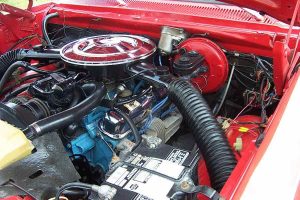
It was almost as quick as a 440-powered ’70 Challenger or Charger.
And like them, it was capable (cue Elwood Blues voice) of running on regular – leaded – gas, which was still available in ’78 but could not be used in vehicles with converters, because it would quickly plug them up.
No worries here. Plus some savings, as leaded cost less than unleaded. Plus it just smelled better – as known by those who remember.
The Express also had – and could do – things no Corvette (or Trans-Am or Z28) had or could, beyond outrun them.
It had a pair of functional smokestack exhaust pipes, the vertical equivalent of the sidepipes some new cars (like the Corvette) once had but were no longer allowed to have – because of catalytic converters and federal drive-by noise regulations.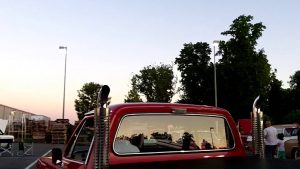
It also had a bed, to haul things while also hauling ass.
This was the Li’l Red Express!
It began as a regular cab/short bed D150 Ram pickup truck, chosen as the starting point by Tom Hoover – considered the father of the famous 426 Street Hemi – and Product Planning and Performance Group members Dick Maxwell and Dave Koffel – for the same reasons Pontiac engineer John DeLorean chose the unassuming Tempest as the foundation for what became the GTO back in 1964.
The truck was basic – and it was relatively light, for a pick-up.
To this was added a high-performance, uncorked version of the venerable Mopar 360 V8, which was a slightly hogged-out version of the hot little 340 small block that powered pre-catalytic muscle coupes like the Dodge Demon/Plymouth Duster.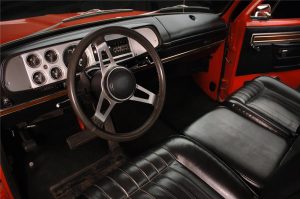
It was originally planned to use a set of very high-performance W-2 heads with a Holley aluminum hi-rise intake perched in between – and a square bore Holley four barrel carb on top of that. But just as Pontiac had been compelled to dial back the ’73-’74 Trans-Am’s SD-455 V8 – which was one of the very last pre-catalyst true high-performance American V8s – Dodge ended up using a less aggressive spread bore intake mounting a Carter ThermoQuad four barrel that was similar to the GM/Rochester Quadrajet in many ways. It was not an outright performance carb like the square bore Holley but it did have 850 CFMs of airflow capability when the secondaries opened up.
There was also a dual-snorkel air cleaner – echoes of the good ol’ days! – and a nice lumpy (for 1978) camshaft with 33 degrees of overlap and 252 degrees of duration, hot for ’78. The 360 also used police-spec SuperFlow cylinder heads and valve springs, a heavy-duty timing chain and was fitted with a special oil pan with a windage tray that wasn’t used in regular production 360s.
It all resulted in 225 net horsepower – a big number for 1978, when the hottest engine you could get in a Trans-Am was the 220 horse 400 (a bigger V8 that made less power) and a meager 185 horsepower 350 powered the Z28. It was essentially identical to the standard 350 small block used in run-of-the-mill Malibus and Novas, with zero high-performance parts to set it apart.
It didn’t even get a dual snorkel air cleaner.
And it couldn’t touch the performance of the Li’l Red Express.
A performance-calibrated set-up 727 Torqueflite three-speed automatic with a higher-stall torque converter was bolted to the back of the 360, with the power multiplied by 3.55 rear gears.
It was the only new vehicle you could buy back in ’78 that could chirp the tires going from first to second . . . with an automatic transmission.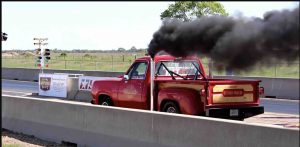
That was as it came.
And because it came without the emissions controls that afflicted cars that year – and did not have to comply with emissions tests – it had uniquely legal potential for higher performance no performance cars of that year offered.
Up the compression from the factory 8.2:1 and maybe install those W-2 heads, some headers and a hotter cam. Get it into the 12s, perhaps – and still get your sticker.
Up yours, Fags!
And then there was the as-it-came exhaust – which was unlike the pipes that came with anything else extant in 1978.
Or, since.
One for each side of the V8, first of all. True duals. As it once was, in high-performance applications. There were zero catalytic converters to interrupt the flow – just a crossover to increase the torque. The sound emanated from a pair of big-rig chromed and heat-shielded stacks on either side of the cab, just aft of the doors, after passing through a set of Street Hemi mufflers.
Giddyap!
The rest of the truck got the treatment, too. Real wood (oak) paneling was used along the bedsides and inset into the tailgate and the bed floor.
Inside, you had your pick of the standard bench or optional buckets. All Li’l Red Express trucks got a full set of gauges and a set of specific chromed, five-slot 15×8 wheels with 60 series tires – huge for 1978 – came as part of the deal.
It sat low, with a noticeable forward rake. Unlike today’s performance trucks, which come standard with four-wheel-drive, the Lil’ Red Express did not even offer it. What kind of Fag would want to interfere with the 360’s ability to light ’em up? Once upon a time, a good burnout was as important as a good quarter-mile time. The Li’l Red Express delivered both.
Dodge’s ad for the thing read as follows:
“Meet the new Li’l Red Truck from Dodge, the truly ‘customized’ pickup that’ll stir excitement even among the most avid ‘truck-truck’ enthusiasts. Best of all, it comes fully equipped from the factory. No need to seek out expensive local customizers and special-equipment suppliers… The new Dodge L’il RED TRUCK will turn a lot of heads… a limited edition pickup with chrome-plated good looks. Only Dodge has it. So, live a li’l…a Li”l RED TRUCK, that is!”
Naturally, it was only available in red, with gold-accent striping and “Li’l Red Express” stenciling on the doors. If you’re going to make a point, make a point! It was impossible to not see this thing.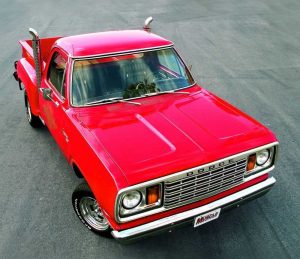
Or hear it. The uncatalyzed sound of yesterday, in the here and now.
It helped people remember what was gone – when it came to performance cars – in 1978. No more Demons and 340 Swingers.
Some 2,188 people wanted a keepsake that year.
The next year, more than twice as many people – 5,118 of them- grabbed a set of keys, intuiting the fun could not last. Indeed, it had already begun to pass.
The ’79 model was saddled with a cat and could no longer burn regular gas. It also got the ridiculous 85 MPH speedometer that the government decreed, as part of the effort to make people feel bad about speed. This proved to be the last year for the Li’l Red Express – the “loophole” having been cinched tight, the fun no longer allowed.
But for two years, you could buy what you used to be able to buy – in the body of a truck instead of a car.
. . .
Li’l Red Express Trivia:
-
- There were two prototype 440-powered Li’l Red Expresses made for the show car circuit.
- The production Lil’ Red Express carried a base price of $7,422 – vs. $5,168 for the base D-150 short-wheelbase pickup. Major options that could be added were buckets seats ($200) and air conditioning ($624).

- 1978 models have round headlights; in ’79 these were changed to square.
- The Li’l Red Express was not available in California – due to emissions and noise compliance issues – intimations of un-fun times ahead. For the same reasons, Pontiac was unable to sell the high-performance version of the Trans-Am in the PRC, the People’s Republic of California. Instead of the 220 horse 400 – with a manual four-speed – they got the 185 horse 400, with an automatic.
- While a red exterior with gold trim was required, Express buyers could select either a red or black-trimmed interior.
- If you didn’t want a Li’l Red Express, Dodge also offered the same thing in black. It was called the Midnight Express.
- Interestingly, the published quarter-mile performance of the ’79 models – which had catalytic converters – is slightly better than the performance numbers posted by the ’78s, which had no cats.
Excerpted from the forthcoming (eventually) book, Doomed.
. . . .
Got a question about cars, Libertarian politics – or anything else? Click on the “ask Eric” link and send ’em in!
If you like what you’ve found here please consider supporting EPautos.
We depend on you to keep the wheels turning!
Our donate button is here.
If you prefer not to use PayPal, our mailing address is:
EPautos
721 Hummingbird Lane SE
Copper Hill, VA 24079
PS: Get an EPautos magnet or sticker or coaster in return for a $20 or more one-time donation or a $10 or more monthly recurring donation. (Please be sure to tell us you want a magnet or sticker or coaster – and also, provide an address, so we know where to mail the thing!)
My eBook about car buying (new and used) is also available for your favorite price – free! Click here. If that fails, email me at [email protected] and I will send you a copy directly!


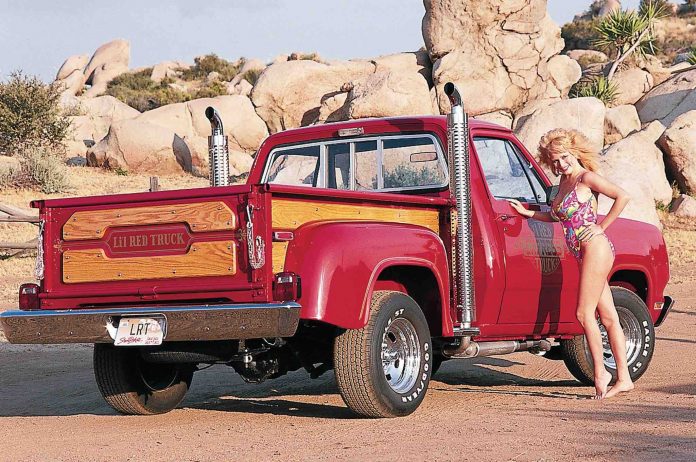









Love this, Eric! Keep ‘em coming!
One thing these trucks also had a lot of is potential. As you mentioned, if what you got off the showroom floor wasn’t hot enough for your liking, it was quite easy and cheap to soup up the engine and transmission, and if you had enough money and knew the right people and right places, you could get some serious power under the hood.
My dad was a Ford man, and he did his share of playing with his F150s to make them better than what Uncle Henry gave you at the dealer. Most of it was for convenience, like better stereos and aftermarket center consoles, but he ditched the 2 barrel on his ‘78’s 351 for a 4 barrel because “it helps you haul heavy loads up hills better” or at least that’s what he said it was for.
Thanks for the write up. I have been around these trucks since they 1st came out and I have to tell you that the article contains some incorrect info. Hopefully you will get the correct info before you write your book. Cheers!
Eric – as a Mopar enthusiast, gonna give a few nitpicks about the Chrysler 360 engine installed in the “Li’l Red Express” Dodge pickup.
Yes, the 360 was, for all practical purposes, the largest V8 that Chrysler offered in passenger cars and light pickups, as the “B” block engines, which as the 70s mercifully ended, were the 400 (3-3/8″ stroke crank) and the 440 (3-3/4″ crank). Chrysler was in severe financial straits, and with the second round of a “gas crisis”, had to downsize both vehicles and engines, so it was just the “LA” engines insofar as V8s were concerned. Although it’s an “LA” engine, it has significant differences from the 273-318-340 engines we all knew and appreciated. The block deck is taller, in order to accomadate the crank with a 3.58″ stroke as opposed to the 3.31″ stroke of the 318, which, BTW, is the same crankshaft as the earlier “A” engine, aka “Canadian” (it was produced at Chrysler Canada’s Windsor Foundry) or “Poly” engine. The standard bore is actually a tad smaller, by 0.040″, than the stock 340, though with an over-boring and selection of appropriate connecting rods, the 360 block can use 340 pistons. However, the cranks don’t interchange as the 360’s main have a 2.81″ main journal diameter; the 360 is also externally balanced with a damper on the crank’s front end, whereas the 273-318-340 is internally balanced. Also, most of the 60s and 70s LA engines had forged steel cranks, it was about 1974 that the 318 switched over to a cast crank as was always the 360’s, the cast crank made of nodular iron proved more than sufficiently durable.
The 360 was intended to replace the venerable 383, which itself was bored out to make the 400 “B” engine, it was the standard engine in full-sized Mopars, save for the higher-trim Chrysler New Yorker and Imperial. At first, all the 360s came with a Carter BBD 2-barrel carb only, and as that was the point where engine compression ratios were lowered to meet emissions standards, it got an undeserved reputation as being a “dog”. As Mopar phased out the bigger “B” (400 cubic inches) and “RB” engines (440) engines, a four-barrel version of the 360 was available. It was the Li’L Red Express which showed that the 360 had every bit the performance potential as its little brothers in the LA engine series, and this engine soldiered on well into the ’80s, and was revised into the 5.9 liter “Magnum” before finally being replaced by the latter-day Hemi engines.
I notice some folks here said they always scoffed at ‘Dodge’ and have also heard others say that about American Motors Corp.
I dont know where these people were in the ’70s but for me these two companies built some of the most stylish and FUN cars that had ever been made. It was a 1970 AMX that first caught my attention at the tender age of 4 years old, owned the 390 4 speed version about 15 years later. Talk about a fun car!
Dodge Demon.. With its raspy 340ci right off the factory floor. My black ’72 Gremlin with the 304 V8, aluminium slots with wide tires and duel exhaust was one of my favorite cars ever. My 1971 Dodge Challenger R/T convertible was so sweet with its 340ci, hood scoops, duel tips ported out the rear valence wraped in its hemi orange paint!
How about Daisy Dukes yellow Road Runner, not to mention the bad a** General Lee!
All I can say to you Dodge/AMC nay sayers is I am sorry. You missed out on a whole lot of fun.. and good times! 🙂
And Eric, Thank you for another awesome read. Yesterday morning I woke up to a beautiful scenic view on the shore of Philpot lake in rural Va. Sat drinking my morning coffee next to a roaring campfire outside our van. Opened up my phone to read this article. My nextdoor neighbor had this truck new in 78/9. Good memories to start off a wonderful day.
My pleasure, Bear!
And – thanks for the kind words. I’m trying to organize a book around the theme (Doomed)… just need to find the time… sigh…
That’s a book I will buy, so please find the time & keep us posted!
This story also got me to thinking today.
If we regularly have fun, and are happy.. we tend to love life and thrive.
The ‘money changers’ want us gone (dead).
This for me explains the war on fun and happiness we have been witnessing all of our lives.
Since counterfeit money is and has been paying for all this evil, not to mention financing the ‘ war on fun’.
Shouldn’t we be demanding the return to a sound currency? Or would this make too much sense?
I do think it is prudent to point out who the real enemy is. The privately owned bank that counterfeits our money.
ie: the federal reserve.
My Uncle had a new 78 LiL Red it was quick but not as quick as a 440 Charger or Challenger..Those ran 12’s in the 1/4,remember road tests were 13.60’s-13.90’s in a 440 Charger with 185/70/14 inch bis ply and the tracks were not like today,they were like side streets..even well int the late 80’s early 90’s…Heck they started in 2nd or eased until 30 mph missing 1st gear!
Stock 1968 440 Charger gaped the Lil Red by several lengths at the track! We knew a guy with a dead stock 68..only mod was ProTrac 275 wide rear tires! Engine,carb,exhaust manifolds were stock! I bought a bone stock elderly lady owned 440 GTX and ran pretty much his numbers 3 years later!Well,she was elderly to me in 1982,she was 59! lol..
Even the smog era 72-74 440 Charger could run mid-high 13’s the 400 versions ran high 13’s..The 360 Challenger in 1974 ran high 5’s 0-60 and 13.90’s and that wasnt near as quick as a 440,383 or even a 67-71 340…
Remember its all about traction,road tests from magazines then were done different…250lbs test equipment..2 passengers and bias ply 185/70 series tires never hooked..Even could easily light the tires on a 318 2bbl that roasted bias ply tires in a 70 Polara I had,it ran high 15’s low 16’s dead stock and 7 years old..older 318’s had a better carb not the smogger carb,they were actually decent….It hooked better off the line and went/no huge traction issues..A 1968 383 2bbl Newport 4 door we had ran 15 flat,not even as quick as a 440 Charger/Challenger of the era..
Today people say their old car is stock and its not..stock rebuilds usually turn out slower than original and even some performance built engines are not as quick as the original…I raced/owned them all…Yes usually they are better but a lot,more than you would think are slower!
Happened to me! My stock (850 holley besides that and exhaust it was stock) 383 Cuda went from a quick mid 13 second daily driver to a rebuilt 383/ca,/etc ran mid 15’s lol..Was I mad!! We corrected it by new crank/cam/heads and went low 12’s,thanks to a old racer machinist in 1983..
**I blew the bottom end of the stock 383 by doing huge John Force style burnouts daily! The 140,000 mile 383 said no,not today one April morning in 1983..The rebuilt 383 lasted until 1992 when I bought that original 68 Charger RT 440,still have it..
We ran a 3 year old 1976 360 2bbl Aspen down the track it ran low 15’s..3.21 rear axle and a 2bbl,no lean burn on it..My buddy kept it stock rolled the odometer 2 times and nearly a 3rd..270,000 miles..very reliable car..replaced the 904 trans once..Sold it 1996 he regretted it.
Good stuff, Mark!
I’ve often thought it would be fun to find and test classic original muscle cars with modern tires (on good tracks). I agree with you about how quick they’re likely run. Years ago, I spoke with some of the Pontiac engineers involved with the ’73-74 SD-455 program. They told that the Trans-Am with this engine was capable of high 12s with slicks and some mild tuning. I believe them!
“federal drive-by noise regulations”
Hmm. Might have to do some digging on this. My catalytic-converter-less vehicle (courtesy of a thief) now sports a short straight pipe off the manifold and is the most obnoxious thing in town.
M’eh. Screw that. Nobody has said anything, or even seems to care. Not even the popo. I’m fortunate enough to live in a state that flips off the organized crime ring known as federal government.
Hi Anon,
Those noise regs are why Pontiac had to rivet shut the Trans-Am’s shaker scoop after 1972. But – bless Pontiac – they made it easy to take the block-off plate off all the way through 1976!
My lovely bride (who loves old Mopar trucks) and I spotted one in Lincoln NH on Tuesday when we went to lunch with the darling daughter.
It was well faded but looked original. It was parked across the street from a mechanic shop, so no doubt it’s owned by someone who appreciates it and knows how to work on it.
Eric wrote:
“Plus it just smelled better – as known by those who remember.”
Oh holy smoke, I thought it was just me.
My daughter and I pulled out the motorcycles a few weeks ago, and started them off with some 100 octane LL (low lead) from the local FBO.
As we rode and passed each other up, I was amazed how big a smile something as simple as the sniff of an exhaust fume could produce.
Where can we buy the “Doomed” book, That is coming out?
I can see it, let me add a chapter: Doomed, retractable headlights.
I have had 2 cars with them and drove a couple others with them and always loved them. They were doomed because they were banned somewhere for being more dangerous when mowing down pedestrians than vehicles with fixed headlights, so we all lost out.
It always brought me joy to flip the lights on and watch the headlights pop up. It was always fun to drive with them up at night too. It was part of the sports car experience that folks don’t get to experience with new vehicles today.
My Charger has the hideaway headlights option. Kids go crazy when the see them go up and down. They think it’s cool.
Well, they Are cool!
I owned a Kit car, the Firebird, not the put together kit. Those headlights were simply, cool. It did seem like one of the best features of the car, besides the power of the time.
Now, when my old neighbor 30-something with his 2000-ish imitation used to drive by with the same feature, it just didn’t seem quite the same with his rounded looking fenders or something about it.
Anyway, one day, one headlight didn’t go back down. That was kinda not cool. Especially because he drove it that way for a long time. It seemed sorta like wearing mis matching shoes or something?
Yeah, once one headlight no longer goes back down, leave them both up. (Looking at you Fiero!)
Some cars looked dorky with the flip-up headlight covers, others looked “bad-ass”. What I recall is some of those early and mid-Seventies Chrysler full-sized cars with those YYYYHUGE bumpers, and with optional bumper guards on that beast with seven feed of hood, you just had a ride that screamed, “FUUUUUCKKK YOU!”
Hey J you mean the smooth rounded corners of the retractables were more dangerous than the massive metal bumpers with all their protrusions, the heavy metal that went into the hood and fenders that protruded past the front frames, the heavy steel wheels, the metal air dams, etc? Trust a sick bureaucrap to dream that up and use it as an excuse to ban a unique item on the cars.
We had a few of those old Chrysler big block cars in our driveway back in the 70s and 80s. Just wish Chrysler had built them to last longer than they did. Now we get all this homo shit that is so hard to service and repair, and has no fun about driving it.
You can still find them out there:
https://www.cars-on-line.com/gen3-cars/col1/posting/105045
There was also the Midnight Express for 1978, the blacked out version of the Lil Red.
I’ve never been a truck guy, but this would be the one if I were!
BTW The Midnite Express Truck was not the same but in black. They were dealer installed package but had 440s not 360s.
In black, with a 440?
Wow, I never knew. The red was pretty cool, imho. I’m having a hard time imagining a black one.
Majic of the Internet:
A photo of a black one is plentiful, how-a-bout that:
https://tse1.mm.bing.net/th?id=OIP.oylPX_70ouuXvhb6tIGtWgHaFj
Anyway, thanks for commenting here, it was a nice break from geoengineering and all the rest.
‘Everybody Knew CV-19 Vax Was a Criminal Bioweapon – Karen Kingston’
https://usawatchdog.com/everybody-knew-cv-19-vax-was-a-criminal-bioweapon-karen-kingston/
OFF GRID with DOUG & STACY
‘Why I wont shop Tractor Supply… The Sunday Brief’
https://www.youtube.com/watch?v=gkBEgFxDLXM
And, I’ve been thinking about the end of this video he did, seemed appropriate to me:
OFF GRID with DOUG & STACY
https://www.youtube.com/watch?v=3WUFeVH6f9E
Doing a burn out in one of those black trucks would be good about here.
One of the first vehicles as a child that caught my attention growing up. There was one close by my home and I remember checking it out every time we rode by in the school bus. I thought it was cool because it was different than any other truck I had ever seen. Thanks for the article, I had no idea it was quite the performer.
I never was a Mopar fan, but my appreciation has grown over the decades. I was still in high school when these came out- and there were a bunch of other specialty Dodges like the Warlock which are late 70’s cool (a phrase with a VERY limited applicability). I’ve been starting to look for one for my toy collection, thanks Eric for likely starting to drive the prices even higher…
My pleasure, Ernie!
I’d enjoy having one of these myself…
One of the first pickup trucks that got people who probably wouldn’t have considered one, had the big cars not gone away. People forget how popular custom vans were in the 1970’s too, due to cars sucking. I wonder if the 1970’s would have been more like the 1960’s car wise, had they not brought in the regs (and the “gas crisis”. Or would have the decline of the car styling of the 70’s brought it to an end anyway?
One of the unintended consequences of the busybodies screwing the auto business. The beginning of the pickup and SUV craze. I doubt any would have become as popular as they did, had it not been for the regs that came out. I really don’t think the big cars actually went out of fashion, they just vanished.
Unfortunately that is what will happen with gas and diesel vehicles too. The automakers will just stop making them.
Vans. I remember when they were considered cool by some. I had some nice Hot Wheels & slot car versions of the ones the young guys in town drove.
Spoilers, flames maybe, the memory of them is fading.
So too, the slogan, “keep on truckin'”
The whole attitude of the 1970’s is fading, I read where someone who was a young man at that time lamented about what happened to that perspective and why it does not seem to be in young people today.
I guess: they sold out, they grew old, faded away, or crashed and burned?
Are the young people of today doing that now, one thumb-click-swipe & like at a time? Idk.
But yeah, a group of us did like the vans, even if we weren’t allowed to drive them at the time.
Hi Helot, My wife and I built a “Custom Van” a few years ago and are enjoying the heck out of it! For us that ’70s vibe is a state of mind. Life is short, might as well be happy while we are here! 😉
a “Custom Van” sounds like a very fine thing to have. And, enjoy.
I saw a 4×4 van a few years ago, I would not mind having that.
I was never a fan of the Li’l Red Express [Or Dodges in general], but every time I see one (Which is pretty much 100% only in pictures) it always reminds me of one of the most awesome trucks I have ever seen:
It was either 1978 or ’79, and teen me was walking one night through the Sheepshead Bay section of Brooklyn, when down the street comes this pale yellow lifted 4×4 long-bed step-side late 70’s[Most likely brand new] Dodge in all it’s glory! That became the image of my “dream truck” for many years. The fact that I’ve always remembered that one truck that randomly passed by on a street 40+ years ago illustrates the impact it made on me- and not just because nice 4×4’s were rare in NYC at that time. And here I am- I’ll 60 in less than a year- and I’d still love to have that truck!
I was a young tike when these were on the streets and fully believed that nothing was cooler than those smoke stacks just like the big rigs had.
I can still remember the last time I saw one of those trucks, over 25 yrs ago. I was fishing near a highway and the driver slowed, smiled, and waved. Then zoomed off. She looked busy and like she was going places. I think she was the brunette version of the model in the top photo.
A nice tease of a memory.
I remember those, top of a very low heap. Styling only a butch lesbian could love.
Cats worked well, if you hollowed them out.
Hi Fred,
Mid 14s stock was pretty solid for ’78 – and what I like most about rigs like this one is how easy (and cheap) it was to make them much more . . . respectable!
Vettes of that era that I have seen ran around 16.0 in the 1/4 mile. Bout the same with the olds powered TAs too.
Used to see lots of those Lil Red Express trucks back in the day but never noticed one at the track. I was not a fan of the styling but if they really ran mid/high 14s I might have liked them in spite of it. I’ve always liked hotrod trucks (plus cars, bikes, and even boats – from a safe distance)
Thanks for the memories. Seems like Dodge did this sort of thing a lot, and now the TRX, wow. Good for them. Sad for me I became a GM/Honda guy early on. I’ve always been a fan of ‘special’ performance variants.
I lusted over the Chevy Citation X-11 but never got one. My first was a GTO Judge, a real one, yousza, but I was a naive young man and totaled it. Then a Honda Civic-Si, which was a very cool little car back then. Then I shifted to needing old man’s cars for my job, and got Bonneville’s and Park Ave’s. Wanted the Bonny SE (late 80’s version) but never got one, then I found the Park Ave. Ultra and it’s blown 3.8 satisfied me. Olds had some decent late 80’s special Cutlass’s and I had one, but the 2-door didn’t work for me. Then no more larger sedans and I went to trucks from then on. V-8 and RWD is mostly why.
The Ford Lightning of early 90’s intrigued me and I went to drive it, and it sucked (for me, no power, no 4-doors). No buy. Still my favorite F150 body style though.
Sorry, I meant the Bonny SSEi, which had the same Park Ave’s 3.8 blown engine, but it looked a little to boy-toy’ish for my job, and why I went Park Ave blown 3.8.
‘The Ford Lightning of early 90’s intrigued me’ — Chris
In the early 20s, Lightning now means electric.
Have to give Ford credit for some supremely sophisticated marketing propaganda. Keying into pickup owners’ instinct for self-sufficiency, this shot shows a hardy couple cleaning up windstorm debris around their $3 million designer home, as their faithful ol’ Lightnin’ in the garage powers not only the whole house but the electric chain saw too:
https://tinyurl.com/prsezjsw
What follows is implied: ‘Let’s fire up the electric grill, honey, and nuke us some steaks …’
Whoa. I didn’t know the Lil Red Truck was actually a production truck. My neighbor up the block has one of these since at least 1981. We stood in front of it on the sidewalk waiting for the school bus. He still has it and it’s still his daily driver. Of course, he actually knows how to turn wrench and tune carbs. I got rid of my 75 bricklin b/c I’m just not smart enough to do it, nor have the time. I even had my Bricklin modernized and customized by Terry Tanner who was the chief engineer of Bricklin and died a few years back.
Great article. I love your articles about the old forgotten cars of yesteryear.
Thanks, Dave!
And I love writing these, too. Much less depressing than Diaper Reports!
It’s great seeing these trucks getting some love, Eric! I remember them well. There was really nothing else like them around and they were highly visible with the arrest-me-red color, wood trim, decals, and of course those vertical exhaust stacks.
I am so fed up with face diapers, high-pressure propaganda (and in some places now, bribes) to get jabbed, and all the contradictory and constantly changing lies being flung around by Pope Fauci and all the other government dirtbags – this article is welcome relief.
For me also – thanks, Jason!
Back int the early 80s my brother and I went to see our maternal cousins in the country. He had a 73 Dodge truck, 4wd, 360 motor, manual, smoked like crazy. It turned out a cousin had got his Ford van stuck at the bottom of a slight hill, that was wet clay and could not get his van up the hill. We put a chain on both trucks, and my brother got in the Dodge and floored the pedal. When the chain went taut, his Dodge jumped up came down, bit into the mud and we got the van back up onto level ground. Left enough smoke behind to suit a steel mill in full heat.